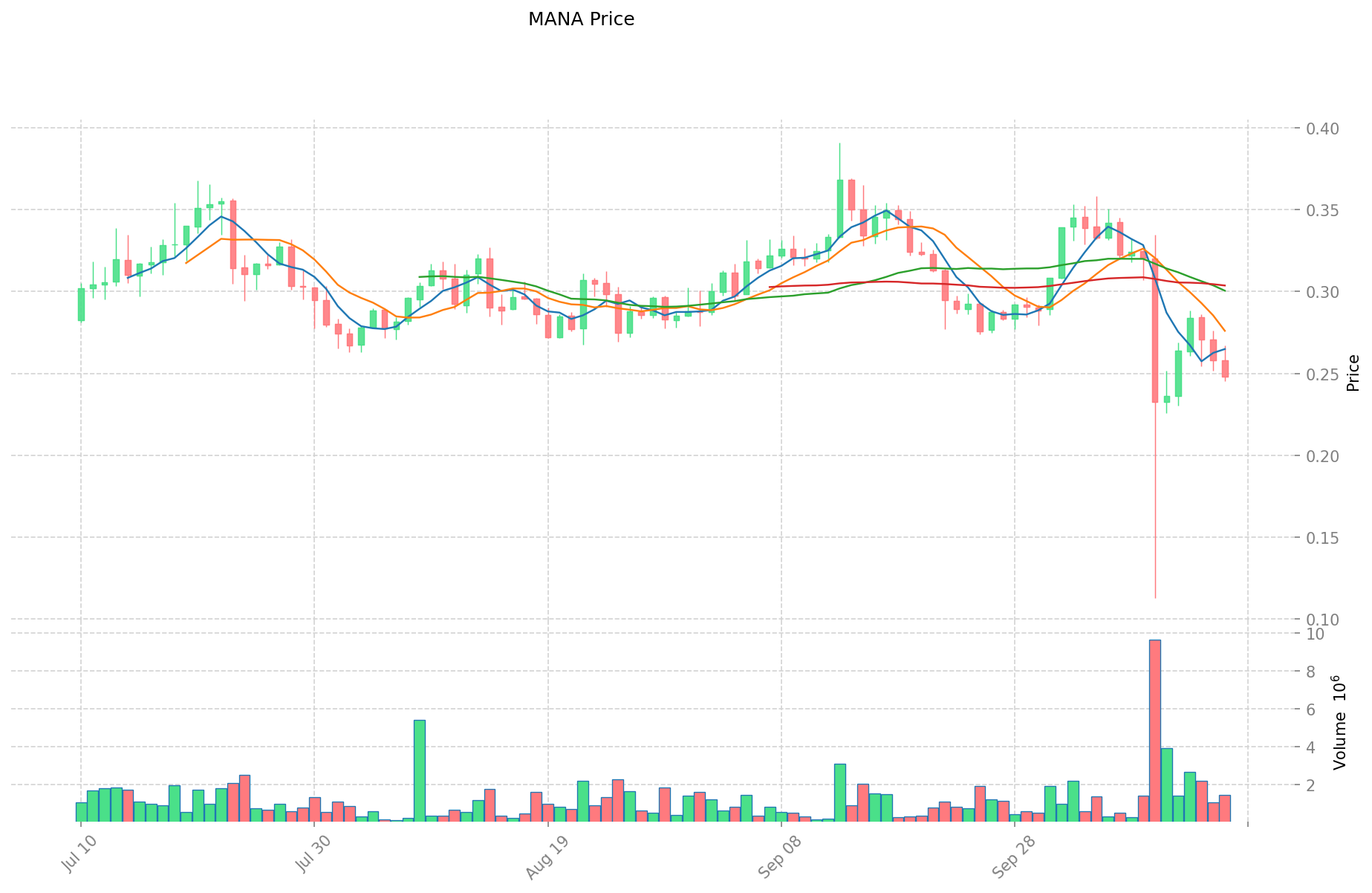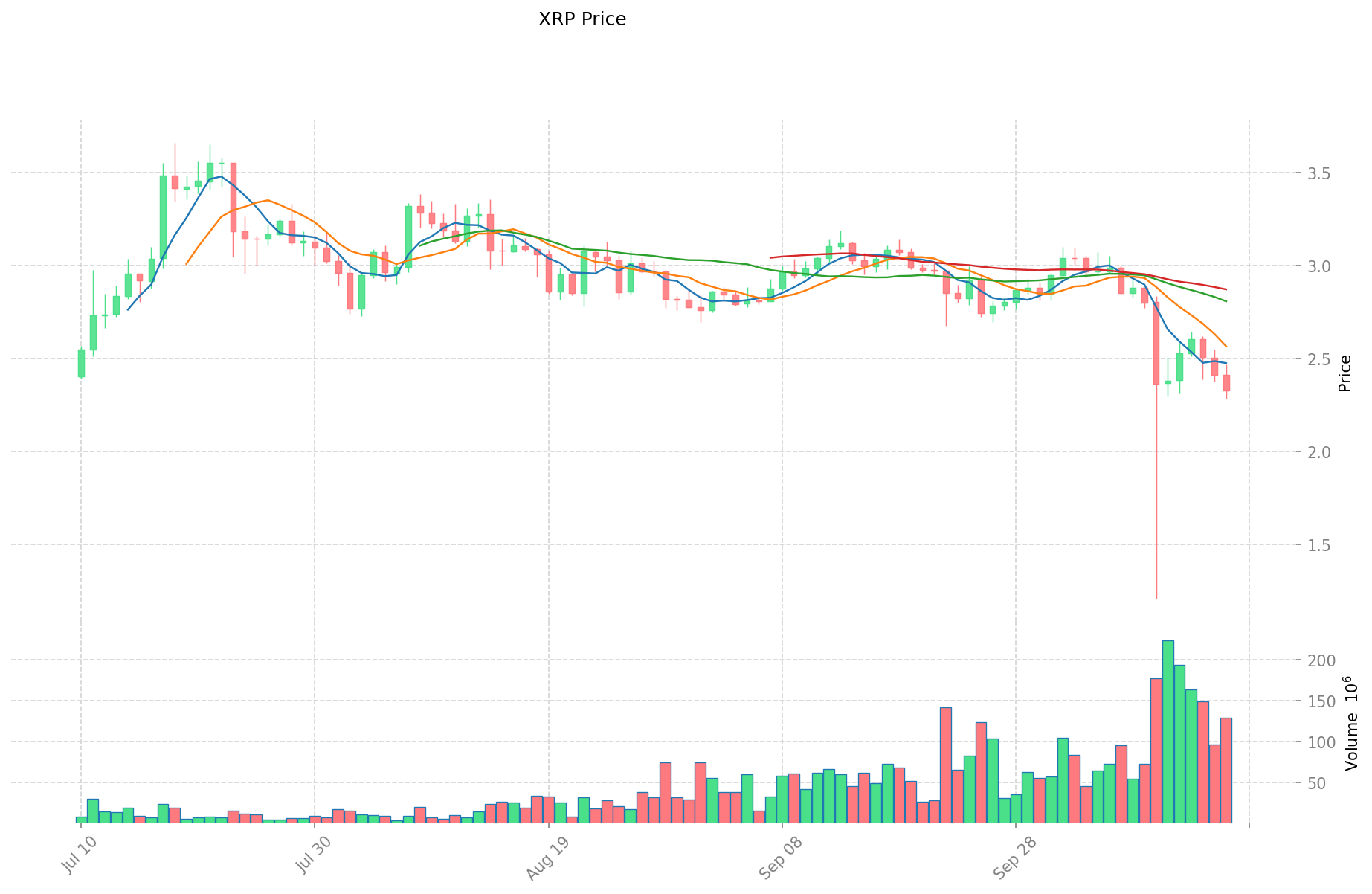MANA vs XRP: Battle of the Digital Assets in the Metaverse and Cross-Border Payments
Introduction: MANA vs XRP Investment Comparison
In the cryptocurrency market, the comparison between MANA and XRP has always been an unavoidable topic for investors. The two not only have significant differences in market cap ranking, application scenarios, and price performance, but also represent different positioning of crypto assets.
Decentraland (MANA): Since its launch in 2017, it has gained market recognition for its virtual world platform based on blockchain technology.
XRP (XRP): Since its inception in 2012, it has been hailed as a digital asset built for payments, and is one of the cryptocurrencies with the highest global trading volume and market capitalization.
This article will comprehensively analyze the investment value comparison between MANA and XRP, focusing on historical price trends, supply mechanisms, institutional adoption, technological ecosystems, and future predictions, and attempt to answer the question that investors care about most:
"Which is the better buy right now?"
I. Price History Comparison and Current Market Status
MANA and XRP Historical Price Trends
- 2021: MANA surged due to the metaverse hype, reaching an all-time high of $5.85.
- 2022: XRP faced regulatory challenges from the SEC lawsuit, causing price volatility.
- Comparative analysis: During the 2022 bear market, MANA dropped from its ATH of $5.85 to a low of $0.28, while XRP showed relatively more stability, maintaining support above $0.30.
Current Market Situation (2025-10-17)
- MANA current price: $0.2491
- XRP current price: $2.33
- 24-hour trading volume: MANA $366,639,770 vs XRP $307,577,769
- Market Sentiment Index (Fear & Greed Index): 28 (Fear)
Click to view real-time prices:
- View MANA current price Market Price
- View XRP current price Market Price


MANA vs XRP: Investment Value Core Factors
I. Supply Mechanism Comparison (Tokenomics)
- XRP: Fixed supply of 100 billion tokens with approximately 55 billion locked in escrow accounts managed by Ripple, releasing 1 billion monthly for predictability
- MANA: Limited supply with tokens used within the Decentraland metaverse economy for purchasing land, goods, and services
- 📌 Historical Pattern: XRP's controlled release mechanism creates predictability while MANA's value is driven by metaverse adoption and utility within the Decentraland ecosystem
II. Institutional Adoption & Market Applications
- Institutional Holdings: XRP has greater institutional recognition with multiple financial institutions adopting Ripple technology for cross-border payments
- Enterprise Adoption: XRP excels in cross-border settlement applications with lower transaction fees and faster processing times; MANA serves as the primary currency in the Decentraland virtual world
- Regulatory Attitudes: XRP faced significant regulatory challenges from the SEC lawsuit but has seen regulatory pressure decrease with leadership changes; MANA faces fewer direct regulatory challenges as a metaverse token
III. Technological Development & Ecosystem Building
- XRP Technical Advantages: Consensus mechanism enabling fast transactions with low fees, particularly suited for cross-border payments; development of RLUSD stablecoin on XRP Ledger
- MANA Technical Focus: Development centered on metaverse infrastructure, virtual reality experiences, and digital asset ownership within Decentraland
- Ecosystem Comparison: XRP has broader financial application potential especially in international payments; MANA's ecosystem is centered around virtual world experiences, digital land ownership, and NFT functionality
IV. Macroeconomic Factors & Market Cycles
- Inflation Performance: XRP's fixed supply and financial use cases position it as potentially inflation-resistant; MANA's value is more tied to digital economy growth
- Monetary Policy Impact: Both cryptocurrencies are affected by broader market sentiment toward risk assets, with institutional money flows particularly impacting XRP
- Geopolitical Factors: XRP benefits from increased cross-border payment demands; MANA benefits from growth in digital economies and remote/virtual interactions
III. 2025-2030 Price Prediction: MANA vs XRP
Short-term Prediction (2025)
- MANA: Conservative $0.17-$0.25 | Optimistic $0.25-$0.31
- XRP: Conservative $1.96-$2.33 | Optimistic $2.33-$3.05
Mid-term Prediction (2027)
- MANA may enter a growth phase, with estimated prices of $0.24-$0.34
- XRP may enter a bullish market, with estimated prices of $2.20-$3.93
- Key drivers: Institutional capital inflow, ETF, ecosystem development
Long-term Prediction (2030)
- MANA: Base scenario $0.35-$0.39 | Optimistic scenario $0.39-$0.49
- XRP: Base scenario $4.23-$5.71 | Optimistic scenario $5.71-$7.00
Disclaimer: This analysis is based on historical data and market projections. Cryptocurrency markets are highly volatile and unpredictable. This information should not be considered as financial advice. Always conduct your own research before making investment decisions.
MANA:
| 年份 | 预测最高价 | 预测平均价格 | 预测最低价 | 涨跌幅 |
|---|---|---|---|---|
| 2025 | 0.306393 | 0.2491 | 0.171879 | 0 |
| 2026 | 0.33885073 | 0.2777465 | 0.18886762 | 11 |
| 2027 | 0.33604549035 | 0.308298615 | 0.2404729197 | 23 |
| 2028 | 0.3543892579425 | 0.322172052675 | 0.1997466726585 | 29 |
| 2029 | 0.358577494627275 | 0.33828065530875 | 0.186054360419812 | 35 |
| 2030 | 0.487800704955217 | 0.348429074968012 | 0.195120281982087 | 39 |
XRP:
| 年份 | 预测最高价 | 预测平均价格 | 预测最低价 | 涨跌幅 |
|---|---|---|---|---|
| 2025 | 3.05361 | 2.331 | 1.95804 | 0 |
| 2026 | 3.25768905 | 2.692305 | 1.69615215 | 15 |
| 2027 | 3.926996073 | 2.974997025 | 2.2014977985 | 27 |
| 2028 | 3.96864603135 | 3.450996549 | 2.17412782587 | 48 |
| 2029 | 4.748571251424 | 3.709821290175 | 2.225892774105 | 59 |
| 2030 | 5.709414965579325 | 4.2291962707995 | 3.510232904763585 | 81 |
IV. Investment Strategy Comparison: MANA vs XRP
Long-term vs Short-term Investment Strategies
- MANA: Suitable for investors focused on metaverse potential and digital economy growth
- XRP: Suitable for investors interested in cross-border payment solutions and institutional adoption
Risk Management and Asset Allocation
- Conservative investors: MANA: 20% vs XRP: 80%
- Aggressive investors: MANA: 40% vs XRP: 60%
- Hedging tools: Stablecoin allocation, options, cross-currency portfolios
V. Potential Risk Comparison
Market Risks
- MANA: Highly dependent on metaverse adoption and virtual world popularity
- XRP: Sensitive to regulatory news and developments in the financial sector
Technical Risks
- MANA: Scalability, network stability
- XRP: Centralization concerns, potential security vulnerabilities
Regulatory Risks
- Global regulatory policies may have different impacts on both, with XRP facing more scrutiny due to its focus on financial applications
VI. Conclusion: Which Is the Better Buy?
📌 Investment Value Summary:
- MANA advantages: Strong position in the growing metaverse sector, potential for digital economy expansion
- XRP advantages: Established presence in cross-border payments, institutional adoption, and faster transaction speeds
✅ Investment Advice:
- New investors: Consider a balanced approach with a slight bias towards XRP due to its more established market position
- Experienced investors: Explore a diversified portfolio including both MANA and XRP to capitalize on different market sectors
- Institutional investors: Focus on XRP for its potential in revolutionizing cross-border payments, while keeping an eye on MANA for future metaverse opportunities
⚠️ Risk Warning: The cryptocurrency market is highly volatile. This article does not constitute investment advice. None
VII. FAQ
Q1: What are the main differences between MANA and XRP? A: MANA is the native token of Decentraland, focused on the metaverse and digital economy, while XRP is designed for cross-border payments and financial applications. MANA's value is tied to virtual world adoption, while XRP's value is linked to its use in international transactions and institutional adoption.
Q2: Which cryptocurrency has shown better price stability? A: Based on historical data, XRP has shown relatively more price stability compared to MANA. During the 2022 bear market, XRP maintained support above $0.30, while MANA experienced a more significant drop from its all-time high.
Q3: How do the supply mechanisms of MANA and XRP differ? A: XRP has a fixed supply of 100 billion tokens, with about 55 billion locked in escrow accounts managed by Ripple. MANA has a limited supply, with tokens used within the Decentraland metaverse economy for purchasing virtual land, goods, and services.
Q4: Which cryptocurrency has greater institutional adoption? A: XRP has greater institutional recognition, with multiple financial institutions adopting Ripple technology for cross-border payments. MANA's institutional adoption is primarily focused on companies interested in metaverse development and digital experiences.
Q5: What are the key factors driving the future price predictions for MANA and XRP? A: For MANA, key factors include metaverse adoption, digital economy growth, and ecosystem development. For XRP, factors include institutional capital inflow, regulatory clarity, and expansion of cross-border payment solutions.
Q6: How should investors approach risk management when investing in MANA and XRP? A: For risk management, conservative investors might consider allocating 20% to MANA and 80% to XRP, while aggressive investors might opt for 40% MANA and 60% XRP. Diversification, stablecoin allocation, and using hedging tools like options can help manage risk.
Q7: What are the potential regulatory risks for MANA and XRP? A: XRP faces more significant regulatory scrutiny due to its focus on financial applications and past legal challenges. MANA, as a metaverse token, currently faces fewer direct regulatory challenges but may be impacted by future regulations on virtual assets and digital economies.
Share
Content